Part of a series of articles titled Park Paleontology News—Vol. 17, No. 2, Fall 2025.
Article
The Incredible Fossil Plants of Yellowstone National Park
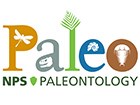
Introduction
Yellowstone National Park is a paradise for anyone interested in the natural world. Encompassing 2.2 million acres at the borders of Wyoming, Montana, and Idaho, Yellowstone is one of the largest national parks in the United States and one of the most visited national parks in the country, attracting over 4.7 million visitors every year. Although the park is most renowned for its fantastic geothermal features, which are sustained by the Yellowstone hotspot, the park is also significant for its long history of exploration, for its tremendous cultural impact, as a haven for wildlife conservation, and as a home to some of the most extraordinary fossil forests in the world.
NPS, Jacob Frank, 2020
The Petrified Forests of Yellowstone
Around 50 million years ago, the Yellowstone ecosystem was a subtropical rainforest, substantially warmer and wetter than it is today. In a scene that must have been as instantaneous as it was destructive, the thriving rainforest was inundated by a flood of fast-moving mud flows mixed with hot, volcanic ash: a type of volcanic deposit which geologists term lahars. Some trees were torn out of the ground and transported, others remained where they originally grew, but all were buried by the volcanic deposits. The trunks of these trees would eventually be replaced by minerals in the silica-rich groundwater, fossilizing the forest. Hundreds of years later, a new forest grew back above where the old forest once stood. The centuries of peace would be brought to an end by another catastrophic lahar flow, consuming the forest as the previous eruptions had done. Layer upon layer of fossil forests accumulated this way in the Yellowstone area. Between eruptions, the volcanic deposits partially eroded into basins; leaf litter that fell into these basins would eventually become fossilized as well. Thus, the layers of fossilized forests also became interlaced with layers of fossil leaves, embedded in siltstones and sandstones. Eventually, dozens of fossil forests accumulated—each successive forest preserved, in place, on top of the last—constituting a substantial portion of Specimen Ridge and Amethyst Mountain in the eastern side of Yellowstone, as well as in the Gallatin Range, on the northwestern side of Yellowstone. At Amethyst Mountain alone, at least 27 layers of fossil forests have been reported!“Nowhere else does there exist the succession of one forest directly above the grave of its predecessor—a succession that emphasizes perhaps more forcefully than any other plant fossil deposit the immensity of geologic time.” — Henry N. Andrews and Lee W. Lenz, 1946
A long history of exploration
Officially the oldest national park in the United States, Yellowstone has had a long history of documentation by western explorers. The 1860s and 1870s saw a series of expeditions and surveys in the Yellowstone area. Prior to this, Yellowstone had been inhabited by indigenous people for at least 11,000 years and was visited by western fur trappers, especially during the height of the North American fur trade (from the late 1700s into the 1840s). However, the region had not been thoroughly mapped. The 1871 Hayden expedition proved to be one of the most monumental of these late 19th century expeditions; a team of scientists, cartographers, a photographer, and an artist provided preliminary documentation of the park’s geologic wonders, including its fossil resources, all of which helped the area achieve National Park status in 1872. The National Museum of Natural History in Washington, DC, still houses petrified logs and leaves collected during this historic expedition! Leo Lesquereux, a highly-regarded paleobotanist of the time, made a preliminary examination of the fossil plants collected during the Hayden 1871 expedition, noting that Yellowstone contained fossils of horsetails, conifers, palms, sycamores, oaks, hickories, serviceberries, and dogwoods, among other plants.William Henry Holmes was the first to publish on the astonishing fossil forests of Yellowstone. His 1878 publication described the fossil forests and layers of fossil leaves from the Absaroka Range, specifically around the Lamar River Valley (around Amethyst Mountain and Specimen Ridge), areas north of the Yellowstone River (such as around Hell Roaring Creek), and in the Gallatin Range. In his attempt to convey the magnitude of the fossil deposits to readers, Holmes (1878) provided a cross-sectional diagram of Amethyst Mountain demonstrating how fossil forests were stacked, in situ, on top of each other. Although Holmes illustrated a 2,000-foot sequence of fossil forests at Amethyst Ridge, he noted that, in the Gallatin Range, these sequences of fossil forests reached between 3,000-4,000 feet in thickness! Felix (1896) identified some of the wood as being related to oaks, laurels, and sycamores.
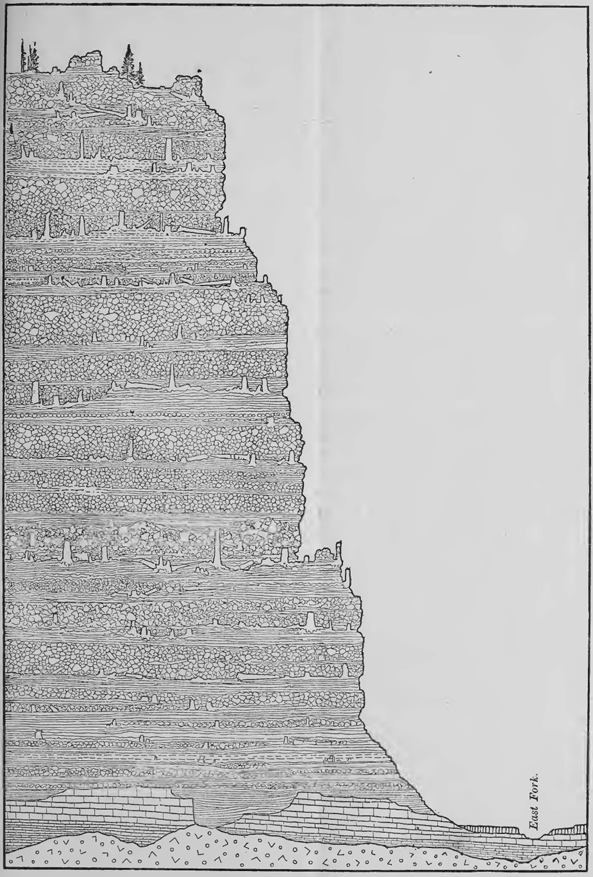
Holmes, 1878
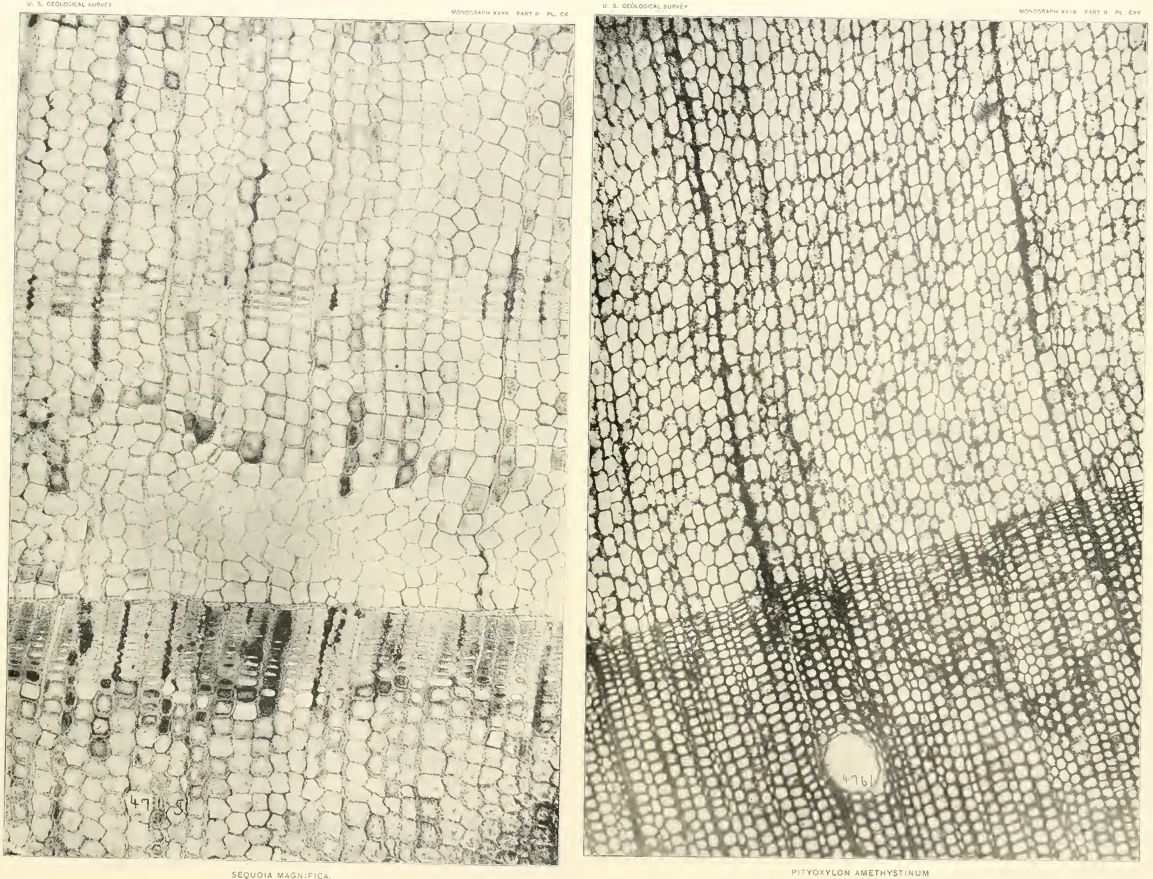
Knowlton, 1899
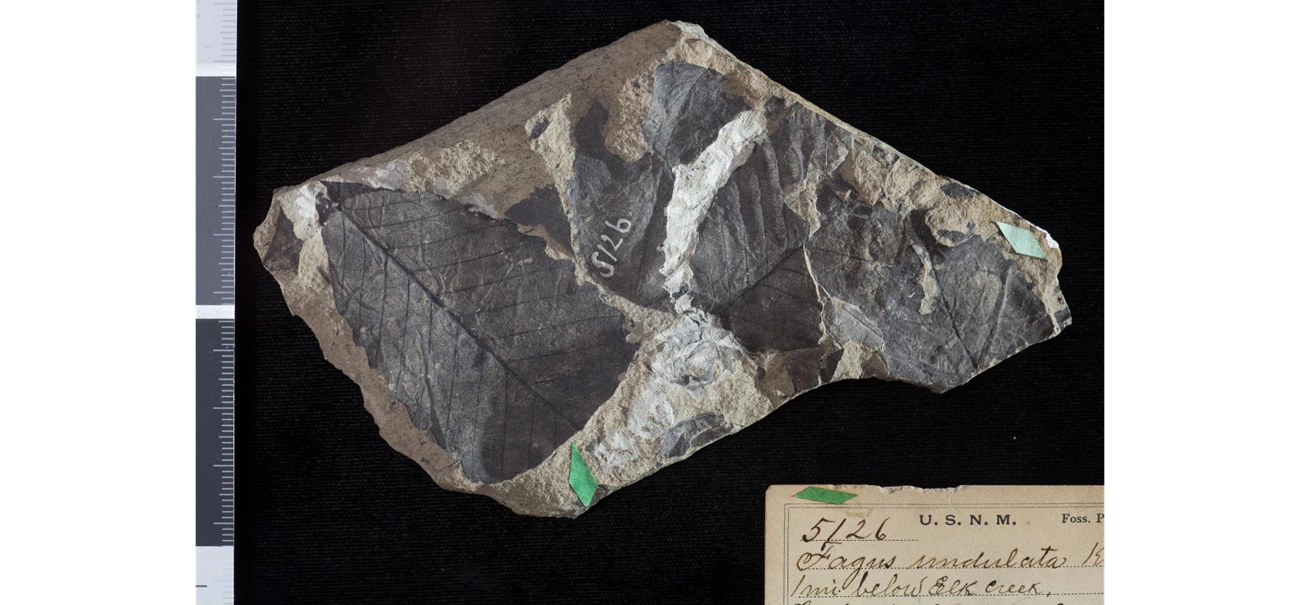
National Museum of Natural History (NMNH), Breann Young
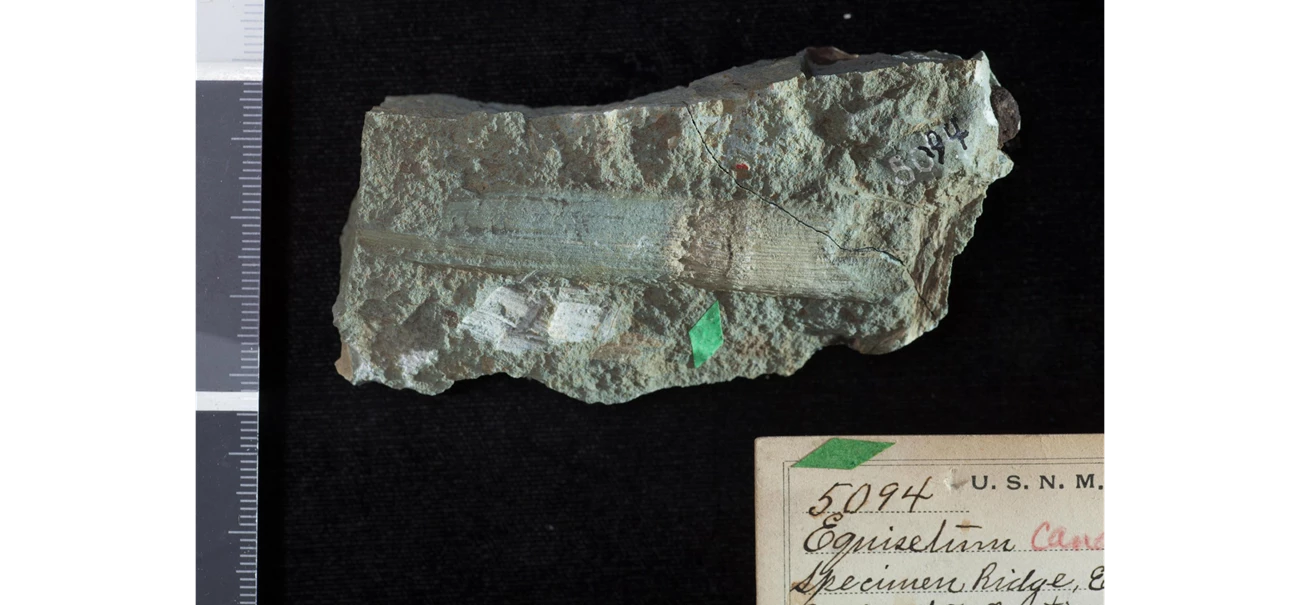
NMNH, Breann Young
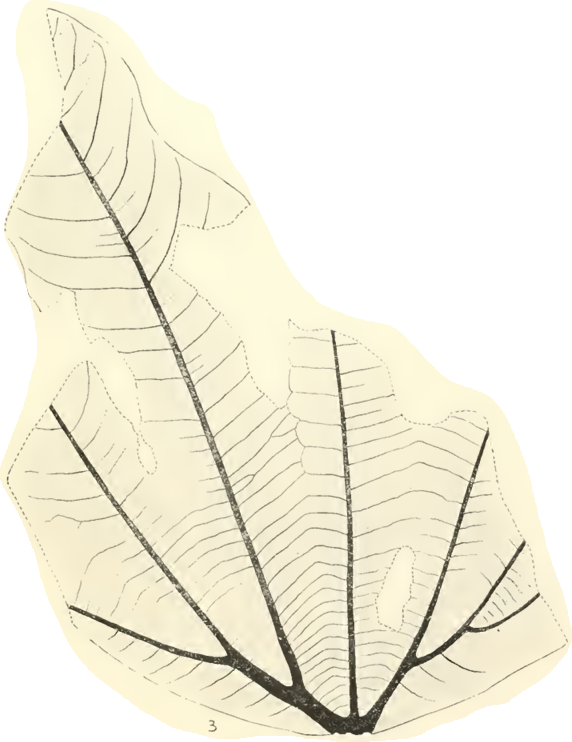
Knowlton, 1899
Fossil Plants of the Lamar River Valley
In the following decades, many authors (Platen 1909, Conard 1930, Read 1930, Beyer 1954) examined the fossil wood from Specimen Ridge and other areas around the Lamar River valley, revealing in greater specificity what types of conifers lived in the area. Erling Dorf, a paleobotanist at Princeton, led numerous trips with students to Yellowstone in the 1950s, discovering that there were even more forest layers at Amethyst Mountain than previously thought (Dorf 1960, 1964). Building on work by Dorf, Wheeler and colleagues (1977, 1978; Wheeler 2024) revealed more detail about the flowering plants represented by the wood fossils, including trees related to magnolias, cashews, dogwoods, birches, oaks, walnuts, laurels, and elms.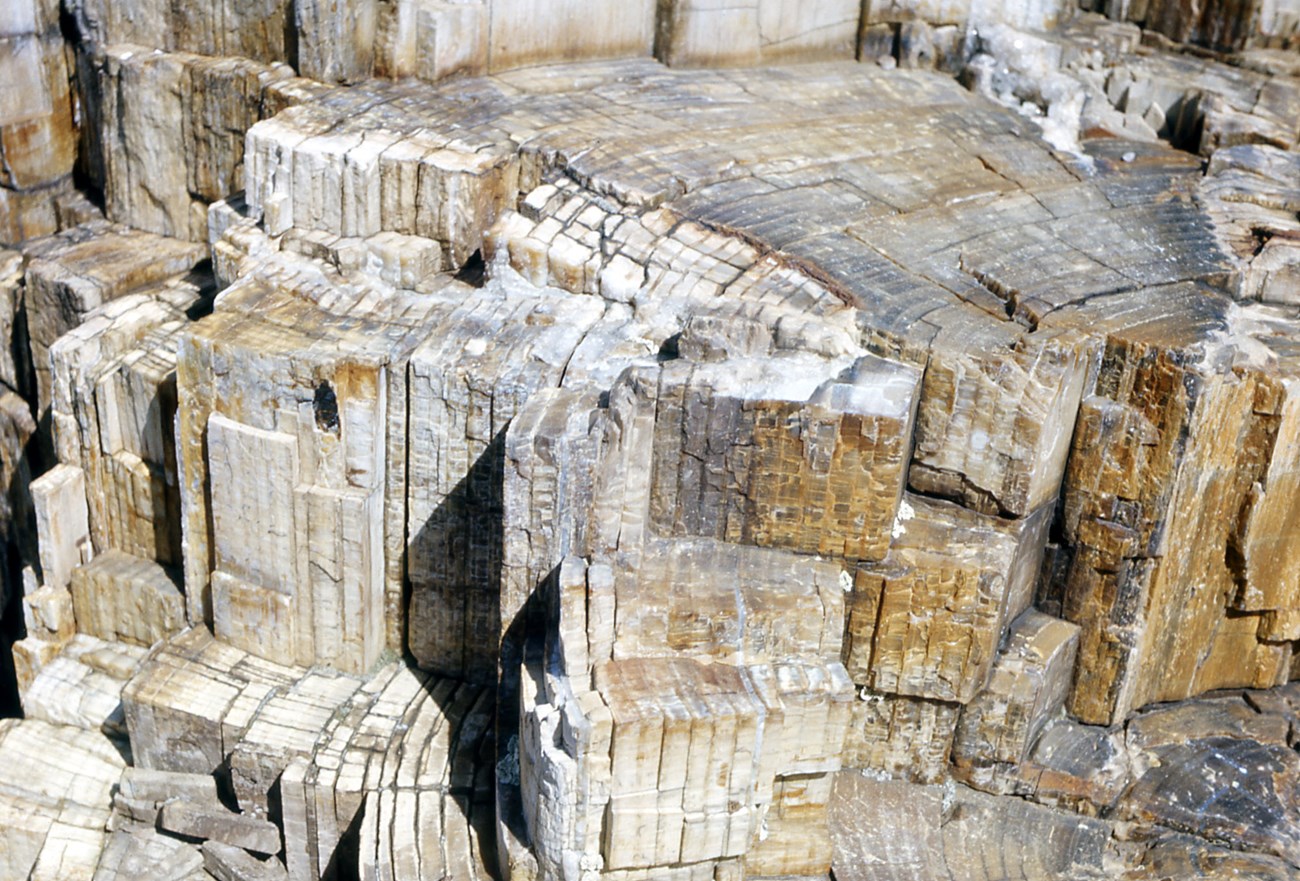
NPS, Bryan Harry, 1965
The Fossil Plants of the Gallatin Basin
The Gallatin Petrified Forest, less accessible than the localities adjacent to the Lamar River Valley, was subject to fewer studies even though it, too, had numerous, spectacular, upright logs (Chapman and Chapman 1935). Knowlton (1896) described a new species of fossil pine (Pityoxylon pealei) from the area, but other types of fossil wood remained unstudied until 40 years later! Researchers found that the sequoia and cypress fossil wood (Andrews 1939) as well as the leaves (Young 1940) around the Gallatin area were similar to those at Specimen Ridge. Andrews and Lenz (1946) described some of the most breathtaking fossil logs from the Gallatin, including a fossil sequoia stump that was 14 feet in diameter and may have lived to be approximately 1,600 years old!
NPS, William W Dunmire, 1970
The Understanding of Yellowstone Geology Improves
Because the deposits of the Absarokas and Yellowstone hotspot were not directly comparable with other rocky mountain deposits, Holmes described the fossil forests as belonging to the "Volcanic Tertiary". As our understanding of Yellowstone’s geology improved, especially with the work of Smedes and Prostka (1972), it became clear that the fossil forests surrounding the Lamar River Valley (attributed to the aptly named Lamar River Formation) were around the same age as the Gallatin Petrified Forests (attributed to the Sepulcher Formation). We now believe that these fossil forests are around 51–49 million years old. Although many spectacular geologic features in Yellowstone were formed by the Yellowstone Hotspot, the Absarokas predate the hotspot activity by more than 40 million years. The 50-million-year-old (Eocene) rocks that contain many of Yellowstone’s plant fossils formed as the result of a much older period of volcanic activity, likely related to the formation of the Rocky Mountains.The Deposition of the Yellowstone Forests
Since the time of Knowlton and Holmes, our understanding of how the fossil forests were preserved has also changed. Based on a few lines of evidence, William Fritz (1977, 1980) and colleagues (Fritz and Fisk, 1979) concluded that the deposits represent a mixture of in situ and transported logs. Each layer of fossil forest contains a mix of plant species that may have preferred growing in very different climates (i.e., some fossils seem like cool-temperate plants while others seem like tropical plants), suggesting that some of the trees, like the cool-temperate conifers, may have been transported from higher elevation slopes down to warmer, lower elevation areas. Each layer also includes a mix of both upright and fallen logs within a specific sequence of conglomerates and siltstones, a pattern that has been observed during modern-day eruptions when forests are hit by volcanic mudflows, also known as lahars. The work of Fritz and colleagues has revealed that the story of the Yellowstone fossil forests was not a 100% in-situ, "layer-cake" scenario.”…on the basis of my original observations in Yellowstone and from more recent data from Mount St. Helens, I think that about 85% of the upright stumps in Yellowstone were preserved in place, although not in layer-cake forests.” - Fritz, 1984

NPS, Justin Tweet
Other plant fossil discoveries
Although the fossil forests of Yellowstone are spectacular, they do not encompass the whole story of fossil plants at the park. In his 1899 monograph, Knowlton described plant fossils of conifers, ferns, and flowering plants (including a new species, Phragmites falcata) from Mount Everts. Knowlton indicated that these fossils were older ("Laramie Formation") than other Yellowstone fossils, but more specific ages for the fossils were unknown until Fraser and colleagues studied the geology again in 1969. They reported that these leaves were came from Late Cretaceous rock layers (the Everts Formation and the Eagle Sandstone), which may be roughly 70 million years old (Tysdal et al. 1986). Later researchers found even more fossil plants (mostly in the form of compressed plant fragments or coal) from Late Cretaceous rocks (Love 1973; Love and Keefer 1975; Santucci, 1998), and Ruppel (1982) reported Jurassic wood from the famous Morrison Formation. Although these older plant fossils have been documented, little has been done since Knowlton’s time to decipher what types of plants they are!Yellowstone also has fossil plants that are younger than its famous petrified forests. Fossil leaves of an extinct sycamore (Macginitiea) were discovered during construction of East Entrance Road in the Lamar River Valley; these fossils come from rock layers that are around 47-46 million years old (Langford Formation; Fritz, 1994). Even younger plant remains and pollen—around 140,000 years old—can be found in the sediments of Yellowstone Lake, especially around the southeast arm (Baker, 1976, 1986; Baker and Richmond, 1978). These fossils have provided us with evidence of a forest dominated by pines and spruces but also inhabited by occasional clubmosses, cinquefoils, oaks, birches, and willows; this suggests that Yellowstone’s conifer forests may have been denser thousands of years ago than they are today (Baker, 1986).
Conclusion
Yellowstone National Park contains an incredible record of prehistoric plant life that goes back more than 70 million years. Its famous petrified forests—excellently preserved down to cellular detail—are layered in multiple areas around the park and in some places amount to thousands of feet in height, making them some of the most impressive sites for fossil wood in the world. Despite the long history of exploration and study at Yellowstone, much still remains to be understood about the what types of plants lived in Yellowstone and what the climate used to be. The leaf fossils interbedded between the famous forest layers have not been evaluated comprehensively in more than 125 years, and other plant fossils in the park, such as the Late Cretaceous leaves of Mount Everts and the younger Eocene leaves of the Lamar River Valley, have largely remained unstudied. This suggests that Yellowstone is a potential treasure trove for new fossil discoveries. Already astonishing for its geysers and massive volcanic deposits related to hot spot volcanism, the fossil flora—preserved by even older periods of intense volcanism and subsequent erosion—are staggering in their own right and make Yellowstone truly like no other place on earth.References
- Andrews, H. N. (1939). Notes on the fossil flora of Yellowstone National Park with particular reference to the Gallatin region. American Midland Naturalist, 454-460.
- Andrews, H. N., & Lenz, L. W. (1946). The Gallatin Fossil Forest. Annals of the Missouri Botanical Garden, 33(3), 309-313.
- Baker, R. G. (1970). Pollen sequence from late Quaternary sediments in Yellowstone Park. Science, 168(3938), 1449–1450.
- Baker, R. G. (1976). Late Quaternary vegetation history of the Yellowstone Lake Basin, Wyoming. U.S. Geological Survey Professional Paper, 729-E, E1–E48.
- Baker, R. G. (1986). Sangamonian(?) and Wisconsinan paleoenvironments in Yellowstone National Park. Geological Society of America Bulletin, 97(6), 717–736.
- Baker, R. G., & Richmond, G. M. (1978). Geology, palynology, and climatic significance of two pre-Pinedale lake sediment sequences in and near Yellowstone National Park. Quaternary Research, 10(2), 226–240.
- Beyer, A. F. (1954). Some petrified wood from the Specimen Ridge area of Yellowstone National Park. American Midland Naturalist, 553-576.
- Chapman, W., and L. Chapman. 1935. The petrified forest. Natural History, 35, 382–393.
- Conard, H. S. (1930). A Pityoxylon from Yellowstone National Park. American Journal of Botany, 17(6), 547-553.
- Dorf, E. (1964). The petrified forests of Yellowstone Park. Scientific American, 210(4), 106-115.
- Dorf, E. (1960). Tertiary fossil forests of Yellowstone National Park, Wyoming.
- Felix, J. (1896) Untersuchungen über fossile Hölzer. 5. Zeitschrift der Deutschen Geologischen Gesellschaft, 48, 249–260.
- Fritz, W. J. (1982). Geology of the Lamar River Formation, northeast Yellowstone National Park.
- Fritz, W. J. (1980). Stratigraphic framework of the Lamar River Formation in Yellowstone National Park. Northwest Geology, 9, 1-18.
- Fritz, W. J., & Fisk, L. H. (1979). Paleoecology of petrified woods from the amethyst Mountain" Fossil Forest", Yellowstone National Park, Wyoming. Natl. Park Serv. Trans. Proc. Ser, 5, 743-749.
- Holmes, W. H. (1878). Fossil forests of the volcanic tertiary formations of Yellowstone National Park. U.S. Geological Survey Territories Bulletin, 2, 125–132.
- Knowlton, F.H. 1899. Fossil flora of the Yellowstone National Park. U.S. Geological Survey Monograph, 32(2), 651–791.
- Knowlton, F. H. (1896). Description of a supposed New Species of Fossil Wood from Montana. Bull. Torr. Bot. Club, 23, 250-252.
- Lesquereux, L. (1872). Fossil flora. In F. V. Hayden, Preliminary Report of the United States Geological Survey of Montana and Portions of Adjacent Territories, Being a Fifth Annual Report of Progress. Washington, DC: Department of the Interior, pp 283–318.
- Platen, P. (1909). Die fossilen Wälden am Amethyst Mount im Yellowstone National Park und de mikroskopische Untersuchun ihrer Hölzer. Prometheus, 20, 241-246.
- Read, C. B. (1930). Fossil floras of Yellowstone National Park. I: Coniferous woods of Lamar River flora: Carnegie Institution of Washington Publication, 416, 1-19.
- Santucci, V. L. (1998). The Yellowstone paleontological survey (p. 54). Yellowstone Center for Resources.
- Ruppel, E. T. (1982). Geology of Pre-Tertiary rocks in the northern part of Yellowstone National Park, Wyoming. Pages 111-137 in Proc. Thirty-third Annual Field Conference, Wyoming Geological Association Guidebook.
- Smedes, H. W., & Prostka, H. J. (1972). Stratigraphic framework of the Absaroka volcanic supergroup in the Yellowstone National Park region (No. 729-C).
- Tysdal, R. G., Marvin, R. F., & Dewitt, E. D. (1986). Late Cretaceous stratigraphy, deformation, and intrusion in the Madison Range of southwestern Montana. Geological Society of America Bulletin, 97(7), 859-868.
- Wheeler, E. A. (2024, January). Fossil woods of Yellowstone National Park. In Parks Stewardship Forum (Vol. 40, No. 1, pp. 181-195). George Wright Society.
- Wheeler, E., Scott, R. A., & Barghoorn, E. S. (1977). Fossil dicotyledonous woods from Yellowstone national park. Journal of the Arnold arboretum, 58(3), 280-306.
- Wheeler, E. F., Scott, R. A., & Barghoorn, E. S. (1978). Fossil dicotyledonous woods from Yellowstone National Park, II. Journal of the Arnold Arboretum, 59(1), 1-31.
- Yamamoto, T., and A. Chadwick. 1982. Identification of fossil wood from the Specimen Creek area of the Gallatin Petrified Forest, Yellowstone National Park, Montana, U.S.A. Part II. Angiosperms. Journal of the San-iku Gakuin Junior College 11: 49–66
- Young, P. A. (1940). Gallatin Petrified Forests. Bulletin of the Torrey Botanical Club, 121-123.
- Yuretich, R. F. (1984). Yellowstone fossil forests: New evidence for burial in place. Geology, 12(3), 159-162.
Last updated: October 1, 2025
